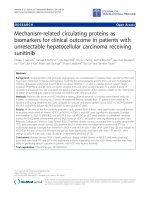Chapter 088. Hepatocellular Carcinoma (Part 11) potx
Bạn đang xem bản rút gọn của tài liệu. Xem và tải ngay bản đầy đủ của tài liệu tại đây (14.66 KB, 6 trang )
Chapter 088. Hepatocellular
Carcinoma
(Part 11)
Carcinoma of the Ampulla of Vater
This tumor arises within 2 cm of the distal end of the common bile duct,
and is mainly (90%) an adenocarcinoma. Locoregional lymph nodes are
commonly involved (50%), and the liver is the most frequent site for metastases.
The commonest clinical presentation is jaundice, and many patients also have
pruritus, weight loss, and epigastric pain. Initial evaluation is performed with an
abdominal ultrasound to assess vascular involvement, biliary dilatation, and liver
lesions. This is followed by a CT scan, or MRI and especially MRCP. The most
effective therapy is resection by pylorus-sparing pancreaticoduodenectomy, an
aggressive procedure resulting in better survival rates than local resection.
Survival rates are ~25% at 5 years in operable patients with involved lymph nodes
and ~50% in patients without involved nodes. Unlike CCC, ~80% of patients are
thought to be resectable at diagnosis. Adjuvant chemotherapy or radiotherapy has
not been shown to be useful in enhancing survival. For metastatic tumors,
chemotherapy is currently experimental.
Tumors Metastatic to the Liver
These are predominantly from colon, pancreas, and breast primary tumors
but can originate from any organ primary. Ocular melanomas are prone to liver
metastasis. Tumor spread to the liver normally carries a poor prognosis for that
tumor type. Colorectal and breast hepatic metastases were previously treated with
continuous hepatic arterial infusion chemotherapy. However, more effective
systemic drugs for these cancers, especially the addition of oxaliplatin to
colorectal cancer regimens, have reduced the use of hepatic artery infusion
therapy. In a large randomized study of systemic versus infusional plus systemic
chemotherapy for resected colorectal metastases to the liver, the patients receiving
infusional therapy had no survival advantage, mainly due to extrahepatic tumor
spread.
90
Yttrium resin beads are approved in the United States for treatment of
colorectal hepatic metastases. The role of this modality, either alone or in
combination with chemotherapy, is being evaluated in many centers. Palliation
may be obtained from chemoembolization, PEI, or RFA.
Benign Liver Tumors
Three common benign tumors occur and all are found predominantly in
women. They are hemangiomas, adenomas, and focal nodular hyperplasia (FNH).
FNH is typically benign, and usually no treatment is needed. Hemangiomas are the
commonest and are entirely benign. Treatment is unnecessary unless their
expansion causes symptoms. Adenomas are associated with contraceptive
hormone use. They can cause pain and can bleed or rupture, causing acute
problems. Their main interest for the physician is a low potential for malignant
change and a 30% risk of bleeding. For this reason, considerable effort has gone
into differentiating these three entities radiologically. Upon discovery of a liver
mass, patients are usually advised to stop taking sex steroids, since adenoma
regression may then occasionally occur. Adenomas can often be large masses
ranging from 8–15 cm. Due to their size and definite, but low, malignant potential
and potential for bleeding, adenomas are typically resected. The most useful
diagnostic differentiating tool is a triphasic CT scan performed with HCC fast
bolus protocol for arterial-phase imaging, together with subsequent delayed
venous-phase imaging. Adenomas usually do not appear on the basis of cirrhosis,
although both adenomas and HCCs are intensely vascular on the CT arterial phase
and both can exhibit hemorrhage (40% of adenomas). However, adenomas have
smooth, well-defined edges and enhance homogeneously, especially in the portal
venous phase on delayed images, when HCCs no longer enhance. FNHs exhibit a
characteristic central scar that is hypovascular on the arterial-phase and
hypervascular on the delayed-phase CT images. MRI is even more sensitive in
depicting the characteristic central scar of FNH.
Further Readings
Furukawa H et al: Living-
donor liver transplantation for hepatocellular
carcinoma. J Hepatobiliary Pancreat Surg 13:393, 2006 [PMID: 17013712]
Goin JE
et al: Treatment of unresectable hepatocellular carcinoma with
intrahepatic yttrium 90 microspheres. J Vasc Interv Radiol 16:161, 2005
Llovet JM et al: A molecular signature
to discriminate dysplastic nodules
from early hepatocellular carcinoma. Gastroenterology 131:1758, 2006 [PMID:
17087938]
Parikh S, Hyman D: Hepatocellular cancer: A guide for the internist. Am J
Med 120:194, 2007 [PMID: 17349437]
Steel JL et al: Clinically meaningful changes in health-
related quality of life
in patients with hepatobiliary cancer. Ann Oncol 17:304, 2006 [PMID: 16357021]
Thorgeirsson S et al: Molecular prognostication of liver cancer: End of the
beginning. J Hepatol 44:798, 2006 [PMID: 16488507]
Bibliography
Bartlett D et al: Cancer of the Liver, in
Cancer: Principles and Practice of
Oncology
, 7th ed, V DeVita et al (eds). Philadelphia, Lippincott Williams &
Wilkins, 2005, pp 986–1009
Carr BI (ed): Hepatocellular Cancer: Diagnosis and Treatment
. Totowa,
NJ, Humana Press, 2005
Hepatocellular Carcinoma. NIH workshop. Gastroenterology 127:S1, 2004
Mizuta T et al: The effect of menatetrenone, a vitamin K2 analog, on
disease recurrence and survival in patients with HCC after curative
treatment.
Cancer 106:867, 2006 [PMID: 16400650]









